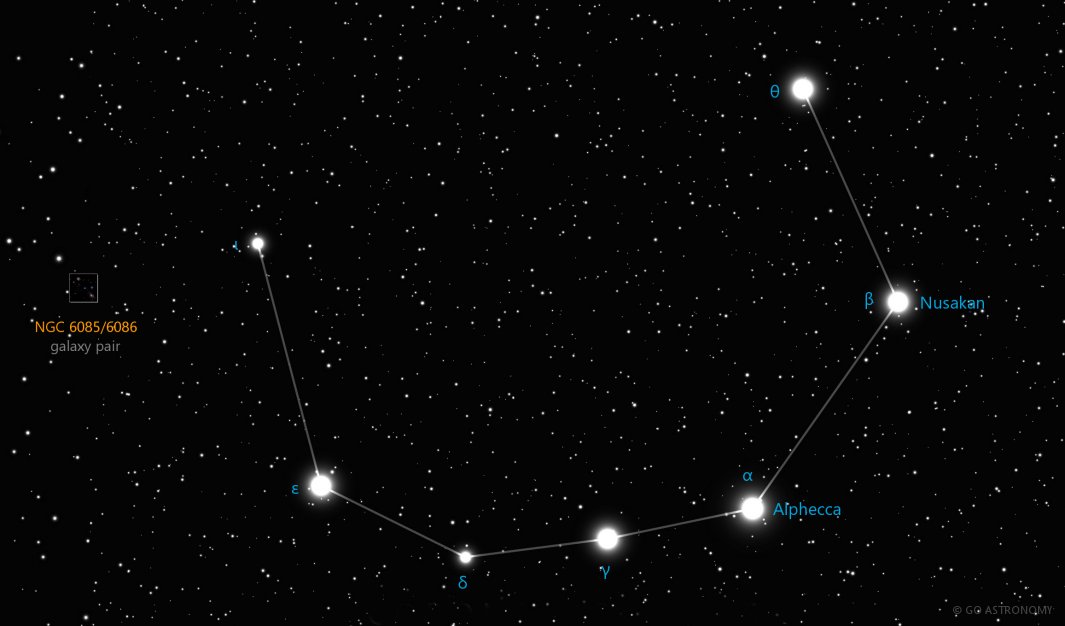Corona Borealis, the Northern Crown (CrB)
(cuh-ROW-nuh bor-ee-AL-iss)
The Northern constellation of Corona Borealis, the Northern Crown, is best viewed in Summer during the month of July.
Corona Borealis is the 73rd largest constellation. It's brightest star is Gemma at magnitude 2.21. The boundary of the Corona Borealis constellation contains 6 stars that host known exoplanets.
- Pronunciation:
- cuh-ROW-nuh bor-ee-AL-iss
- Meaning:
- Northern Crown
- Genitive:
- Coronae Borealis
- Abbreviation:
- CrB
- Constellation Family:
- Ursa Major
- Hemisphere:
- Northern
- Quadrant:
- NQ3
- Visibility:
- 90° N - 50° S
- Best viewing month*:
- July
- Area:
- 179 sq. degrees
- Size:
- 73rd largest
- Right Ascension (avg):
- 15h 53m
- Declination (avg):
- 32°
- Brightest star:
- Gemma (2.21)
- Stars with planets:
- 6
- X-ray stars:
- 2 (binary) stars
- Messier objects:
- |
- Caldwell objects:
- |
Brightest Stars in Corona Borealis
The 10 brightest stars in the constellation Corona Borealis by magnitude.
- Star
- Magnitude
- Spectral class
- Alpha Coronae Borealis (α CrB)
- 2.22
- A0V
- Beta Coronae Borealis (β CrB)
- 3.66
- F0p
- Gamma Coronae Borealis (γ CrB)
- 3.81
- A1Vs
- Theta Coronae Borealis (θ CrB)
- 4.14
- B6Vnn
- Epsilon Coronae Borealis (ε CrB)
- 4.14
- K3III
- Delta Coronae Borealis (δ CrB)
- 4.59
- G5III-IV
- Zeta Coronae Borealis (ζ CrB)
- 4.64
- B7V+
- Tau Coronae Borealis (τ CrB)
- 4.73
- K0III-IV
- Kappa Coronae Borealis (κ CrB)
- 4.79
- K0III-IV
- Xi Coronae Borealis (ξ CrB)
- 4.86
- K0III
Double Stars in Corona Borealis
These are the brightest and easiest-to-find double, triple, and quadruple star systems in the constellation Corona Borealis . Also see all star clusters.
- Star system
- Magnitudes
- Type
- Zeta Corona Borealis
- 5.0, 5.9
- double
- Sigma Corona Borealis
- 5.6, 6.5
- double
The Northern Celestial Crown
Corona Borealis, which translates to "The Northern Crown," is a small, distinctively shaped constellation in the Northern Hemisphere. With its easily recognizable arc of stars, it has been a prominent feature in the night sky across cultures and throughout history.
Historical Overview
The constellation's story can be traced back to ancient civilizations. In Greek mythology, Corona Borealis is associated with the crown of Ariadne, the daughter of King Minos of Crete. Other cultures, such as the Native American Iroquois, perceived the constellation differently, seeing it as the story of a celestial porcupine.
Location and Notable Features
Corona Borealis lies at celestial coordinates of approximately 16h 00m 00s (right ascension) and +30? 00' 00" (declination). This constellation is surrounded by Bo?tes to the west, Hercules to the east, and is nestled between the arms of Serpens Caput to the south and Ursa Major to the north.
The constellation's brightest star, Alphecca (or Gemma), is a binary star that shines with an apparent magnitude of 2.2. This class A white main sequence star is a member of the Ursa Major Moving Group, a collection of stars with similar motion through space. Alphecca, along with a semicircle of six other stars, makes up the distinctive crown shape of Corona Borealis.
Deep Sky Objects
While Corona Borealis is small and has fewer stars compared to other constellations, it hosts some intriguing deep-sky objects. The galaxy cluster Abell 2065, about one billion light-years away, contains over 400 galaxies and is a strong source of X-rays. This galaxy cluster is best viewed with powerful telescopes and offers astronomers insights into large-scale cosmic structures and dark matter.
The constellation is also home to several interesting variable stars, including R and T Coronae Borealis. R Coronae Borealis, in particular, is a unique type of variable star known for its unpredictable and dramatic drops in brightness.
Observing Corona Borealis
Corona Borealis is best observed from the northern hemisphere, particularly in the summer months when the constellation is high in the sky. Its pattern of stars, resembling a crown or a "C" shape, makes it fairly easy to identify. The best way to find it is to locate the brighter constellations of Bo?tes and Hercules, then look between them.
A small telescope or a pair of binoculars will provide a closer look at the constellation's main stars, while more powerful telescopes are required to observe deep-sky objects like Abell 2065.
* Constellation shown for northen hemisphere skies. For the southern hemisphere, constellations appear rotated 180 degrees (upside-down and left-right reversed) from what is shown. Remember that seasons are reversed too - summer in northern latitudes is winter in southern latitudes.
** Circumpolar constellations are visible year-round in the hemisphere listed (and not at all in the opposite hemisphere).




